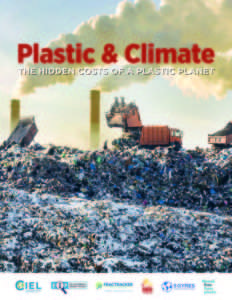
Amidst growing concern about the impacts of plastic on the oceans, ecosystems, and human health, there’s another largely hidden dimension of the plastic crisis: plastic’s contribution to global greenhouse gas emissions and climate change. Plastic & Climate: The Hidden Costs of a Plastic Planet examines each of these stages of the plastic life cycle to identify the major sources of greenhouse gas emissions, sources of uncounted emissions, and uncertainties that likely lead to the underestimation of plastic’s climate impacts. The report compares greenhouse gas emissions estimates against global carbon budgets and emissions commitments, and it considers how current trends and projections will impact our ability to reach agreed emissions targets. It also compiles data, such as downstream emissions and future growth rates, that have not previously been accounted for in widely used climate models. This accounting paints a grim picture: plastic proliferation threatens our planet and the climate on a global scale.
Read the full report.
Read the four-page executive summary.
Read the press release.
Read the highlights.
Executive Summary:
- Plastic & Climate in English
- 塑料与健康 – Chinese
- El Plastico y la Salud – Spanish
- Plastik & Klima – German
Key Figures:
Figure 1: Annual Emissions from the Plastic Lifecycle
Figure 2: Annual Plastic Emissions to 2050
Figure 6: World Plastic Demand May Increase Significantly
Figure 8: Emissions Associated with Natural Gas Extraction
Figure 9: Potential Greenhouse Gas Emissions from Ohio River Valley Petrochemical Buildout
Figure 10: Greenhouse Gas Emissions from US Industrial Sites that Produce Ethylene
Figure 18: Net CO2 Emissions from Plastic in the EU Could Grow by 76% by 2050
Table of Contents:
Executive Summary
Chapter 1: Introduction
Chapter 2: Methodology
Chapter 3: Calculating the Climate Costs of Plastic
Estimates of Cradle-to-Resin Emissions Rates
Previous Efforts to Measure Plastic’s Lifecycle Impact
Plastic Production Growth Estimates 2015–2100
Estimating Plastic’s Impact on Global Carbon Budgets
Chapter 4: Extraction and Transport
The Origins of Plastic: Olefins
The Growth of Petrochemical Production
Greenhouse Gas Emissions from Oil and Gas Production for Plastic Feedstocks
Natural Gas in the United States
Greenhouse Gases from Natural Gas Extraction
Hydraulic Fracturing
- Venting and Flaring
- Leaking Tanks and Pipelines
- Transport
- Water Hauling
- Waste Disposal
- Other Traffic
Pipeline Construction and Compressor Stations
- Land Disturbance
Natural Gas Storage and Disposal
Gas Processing
Case Study: Pennsylvania
Extraction and Transport Emissions Gaps
Chapter 5: Refining and Manufacture
Challenges of Calculating Emissions from Refining and Manufacture
Emissions Sources
Steam Cracking
Case Study: US Ethylene Production and Projected Expansions
Resin Manufacturing
Plastic Product Manufacturing
- Reducing Emissions in Plastic Manufacturing
Chapter 6: Plastic Waste Management
“End of Life” is Not End of Impact
Greenhouse Gas Emissions from Plastic Waste Disposal
Waste Incineration and Waste-to-Energy
- Landfilling
- Recycling
- Other Known Unknowns
An Alternative Path: Zero Waste
Chapter 7: Plastic in the Environment
Plastic in the Ocean
Greenhouse Gas Emissions from Plastic: Hawaii Case Study
- Virgin vs. Aged Plastic
- Physical Features
Estimating Direct Greenhouse Gas Emissions from Ocean Plastic
Potential Impact of Microplastic on the Oceanic Carbon Sink
Reducing the Climate Impact of Plastic in the Environment
Chapter 8: Findings and Recommendations
Plastic and Cumulative Greenhouse Gas Emissions
Lifecycle Plastic Emissions Relative to Mitigation Scenarios and Carbon Budget Targets
Recommendations
- High-Priority Strategies
- Complementary Interventions
- Low-Ambition Strategies
- False Solutions
